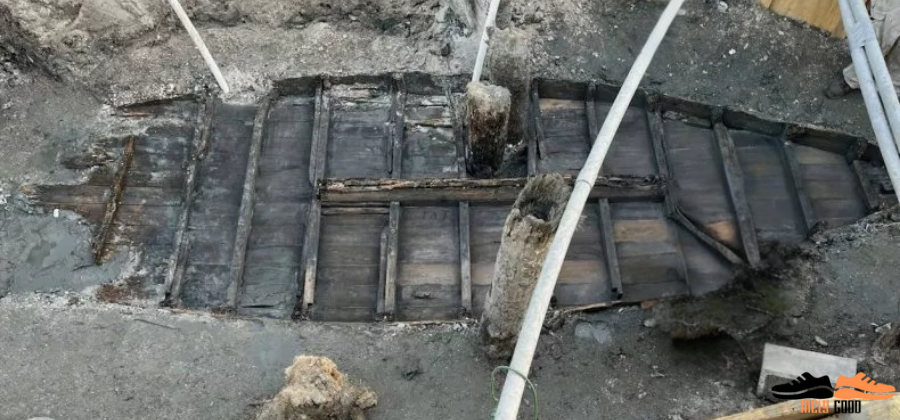
puente en St. Augustine, Florida, durante un proyecto de mejora del drenaje. El naufragio estaba enterrado bajo entre 8 y 10 pies de sedimento y contenía varios artefactos, incluyendo zapatos, monedas y una linterna. Es probable que el naufragio fuera un bote de vela local de los años 1800, pero se desconocen su origen y propósito exactos. El naufragio fue desmontado y retirado cuidadosamente por arqueólogos, quienes trabajarán para encontrarle un hogar permanente.
Puntos Clave:
- El naufragio de 150 años fue descubierto enterrado cerca del Puente de los Leones en St. Augustine, Florida, durante un proyecto de drenaje. Probablemente date de los años 1800.
- El naufragio de 20 pies contenía zapatos, monedas, una linterna y otros artefactos. Fue excavado y retirado cuidadosamente por arqueólogos.
- El barco era un bote de vela construido localmente utilizado para propósitos domésticos. Su origen y propósito exactos siguen siendo un misterio. Se necesita más investigación.
- Los artefactos encontrados en el naufragio, como los zapatos y monedas, ayudaron a datarlo alrededor de 1869. Los zapatos tenían diseños separados para izquierda/derecha, una innovación de los años 1800.
- Después de la documentación, el naufragio fue desmontado y puesto en almacenamiento húmedo. Los arqueólogos trabajarán para encontrar un hogar permanente para este hallazgo histórico.
- St. Augustine tiene una rica historia marítima, con 75 naufragios conocidos en alta mar desde sus días coloniales. Algunos naufragios han producido tesoros.
- La ciudad tiene un Museo de Naufragios que muestra artefactos de naufragios famosos como el Titanic, galeones españoles, etc.
- Este nuevo descubrimiento se suma al legado marítimo y plantea preguntas sobre los orígenes, el propósito y el destino del barco. Proporciona información sobre el pasado.
- El arqueólogo lo llamó un descubrimiento emocionante y una oportunidad poco común para aprender sobre nuestra herencia y conexión con el mar. Los naufragios históricos nos intrigan.
El naufragio casi completo fue descubierto cerca del Puente de los Leones en St. Augustine, el asentamiento europeo y afroamericano ocupado de forma continua más antiguo de los Estados Unidos, fundado en 1565. El naufragio de 20 pies de largo fue extraído por arqueólogos del Departamento de Transporte de Florida, quienes se sorprendieron con el hallazgo.
“No teníamos indicios de que la embarcación estuviera presente”, dijo Ian Pawn, arqueólogo del Departamento de Transporte de Florida, a Newsweek. “La embarcación estaba enterrada bajo casi 8-10 pies de sedimento y posterior desarrollo de St. Augustine, como la extensión hacia el este del malecón, relleno y partes de la estación de tranvía de principios del siglo XX. Incluso se clavó una gran estaca de madera de palma a través de la embarcación (probablemente para amarrar barcos), lo que indica que la embarcación ni siquiera se conocía a finales del siglo XIX/principios del siglo XX”.
Pawn dijo que, sin marcas identificadoras, es difícil saber exactamente de dónde vino el barco o para qué se utilizaba.
“Queda mucho por investigar, y es posible que nunca conozcamos esos detalles exactos”, dijo.
Sin embargo, los arqueólogos sí saben que probablemente era un bote de vela. Si bien la cubierta y el casco del bote estaban “bastante bien conservados”, no se encontró ningún mástil.
“La embarcación es lo que se conoce como vernácula, lo que significa que probablemente fue construida localmente, con materiales locales, para uso doméstico. Los artefactos, muchos ubicados sobre la embarcación enterrada, ayudaron a confirmar la datación inicial de la embarcación”, dijo Pawn. “Los hallazgos incluyeron zapatos de cuero (incluyendo diferentes zapatos para izquierda y derecha, una innovación del siglo XIX), monedas (una fechada en 1869), medias cocos que probablemente se usaban como tazas, y una parte de una linterna de aceite”.
El bote fue desmontado, tabla por tabla, y retirado, con gran cuidado para mantener cada parte húmeda.
“Las piezas se observarán en un almacenamiento húmedo para estabilizarse mientras determinamos los futuros esfuerzos de conservación. Trabajaremos en estrecha colaboración con arqueólogos y la Ciudad de St. Augustine para encontrar un hogar permanente para este hallazgo único”, dijo Pawn.
St. Augustine es conocida por su rica historia y patrimonio marítimo. Se dice que hay 75 naufragios cerca de St. Augustine, Florida, debido a un gran banco de arena que debe cruzarse para entrar en la laguna. Algunos de estos naufragios se remontan a la era colonial española y han producido valiosos tesoros y artefactos.
St. Augustine también tiene un Museo de Naufragios que muestra una variedad exclusiva de exhibiciones y experiencias atractivas que descubren algunos de los naufragios más famosos e interesantes del mundo, incluido el R.M.S. Titanic, el Nuestra Señora de Atocha, el S.S. Central America, la Flota Española de 1715, tesoros marítimos de China, el Mediterráneo y más.
El descubrimiento del naufragio de 150 años cerca del puente agrega otra capa de misterio e intriga al legado marítimo de St. Augustine. También plantea preguntas sobre quién lo construyó, quién lo navegó y qué le sucedió.
“Siempre es emocionante encontrar algo así”, dijo Pawn. “Es una oportunidad poco común para aprender más sobre nuestro pasado y nuestra conexión con el mar”







